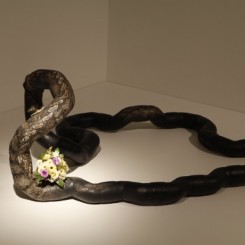But all this having been said, things have to start somewhere — it’s about time — and why not with an extensive exhibition of works by contemporary Indian artists both established and more new? This is certainly a refreshing show — not least for its ability to rouse Beijing-based audiences (here read critics, too) from their comfort zone. From the word go, here are unfamiliar, engaging works. “Indian Highway” begins in UCCA’s smaller rooms with mostly video and graphic pieces. An unmasked socio-politics is clear from the start with Ayisha Abraham’s composite film “You Are Here” (2007), a mirage of 8 and 16 mm private and public footage. “I Love My India” (2003), the hard-hitting video by Tejal Shah featuring public responses to the Muslim genocide in Gujarat in 2002, has already been removed at the behest of the Indian side concerned about its reception in China. As further works accumulate, one feels the presence of a nostalgia which is both intact and at the same time at rest. In this vein, an untitled series from “The Gate Crash” (2008) by Avinash Veeraraghavan overlays across four panels the imagery of imagination and play (childhood objects, dolls’ houses) with adult possessions. Meanwhile, at the end of the room, an installation, “Cult of Survival” by Jagannath Panda (2010), fuses snake hide with industrial rubber in a metamorphic loop, a form which forcefully manifests the power of development, writhing off the skin of before.
After a particularly engaging graphic series by Sarnath Banerjee (“The Harappa Files,” 2010) and three voraciously decorative pieces by Bharti Kher wherein thousands of bindis swarm in patterns as if set free (“The Internal Workings of My Mind When the Body is Sleeping,” 2012), the exhibition swells out into a veritable panorama of large and varied works. It is difficult to pinpoint the collective atmosphere here. Beijing has seen next to no Indian art, and one imagines most viewers have little familiarity with the cultural context. Artworks may have been skilfully presented, but (as yet) lack presence. Despite the physical immediacy, there are nuances lost in translation. To meet with such a collection of unfamiliar things in a white room was a reminder, perhaps, of quite how internationalized mechanisms process and present contemporary art. For whom do they present it and — where is it in relation to its sources, with what destination in mind?
The works’ import contains strains one doesn’t readily associate with contemporary art from China: amongst those cherished now in the Chinese art scene are a number of robust auteurs — conduits for measured, existential accumulations of paint, for example, or taut conceptual edifices summoned from discarded wood; also prominent are young, reflective individuals finding personal expression through immersive media like video. But in “Indian Highway,” the broader public features prominently, for instance in the “Baggage Claim” paintings (2010) by Jitish Kallat, and “Come Give Us a Speech” (N.S. Harsha, 2008 — the poster for the exhibition), as do depictions of social “types” as in the aforementioned “Harappa Files.” One has the impression of formal rawness, too, that is unusual amongst the technically refined installations displayed in Beijing’s high-end galleries. The latter comes across powerfully in Sheela Gowda’s “Darkroom” (2006): tar drums stacked to create a boxlike container with a dreamy mirror effect inside; and in “8 feet x 12 feet” by Hema Upadhyay (2009), a four-sided cube lined with miniature corrugated slum-shacks, tower blocks and road ways. A glittering, conflated world at once local and global — its walls entrap one’s gaze. Finally, a photographic work like “The Shroud” by Ravi Agarwal — a figure standing by the Ganges completely veiled in white and tied like a travellng object — evokes an incorporeal tie between the people and the river in a state of both sanctity and dissolution. Although sweeping generalizations feel even less applicable to contemporary art, one has a sense of societal kinship — generosity, even — which is not prominent now in the collective personality of Chinese works.
Perhaps this big exhibition not only introduced contemporary Indian art to audiences elsewhere, but also provided aesthetic and sensory counterpoints to artistic production wherever it lands. There was much here to attract thinking about the relationship between art and life, and between art and art, but also to force us to consider what “globalization” really means at this moment for international exhibitions.
